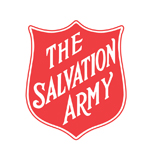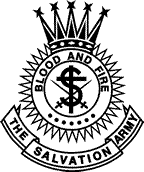Our Symbols
The Red Shield
 The Red Shield is an internationally recognised symbol of Salvation Army service to those in need.
The Red Shield is an internationally recognised symbol of Salvation Army service to those in need.
At the turn of the century, one of the symbols of The Salvation Army was a silver shield with the words ‘Salvation Army’ emblazoned across it. The shield was worn as a badge by many Salvation Army personnel, particularly those serving with the Defence Forces.
In the aftermath of the Boer War, an Australian Salvationist, Major George Carpenter, was concerned that the silver shield worn by Salvationists in times of war would reflect light, particularly during the night, giving the location of troops to the enemy. As a result, the silver was replaced by the red enamel and became known as the ‘Red Shield’. The pattern is the same internationally, with only the language being different.
Today, the Red Shield logo used on signage, printed materials and fundraising appeals has white lettering and border on red background. The shield usually has gold lettering and border when used as part of a Salvationist’s uniform on the cap or collar badges.
Because the Red Shield emblem came to represent The Salvation Army’s reputation for being at the frontline of need, the Red Shield was incorporated into the name of The Salvation Army’s annual fundraising drive in Australia, the Red Shield Appeal.
The Crest
 The crest is a meaningful symbol of the Salvationist’s beliefs.
The crest is a meaningful symbol of the Salvationist’s beliefs.
Captain William Ebdon designed the crest in 1878 and the only alteration to his original design was the addition of the crown. Its emblems set forth the leading doctrines of The Salvation Army as follows:
- The sun (the surround) represents the light and fire of the Holy Spirit
- The cross of Jesus stands at the centre of the crest and the Salvationist’s faith
- The ‘S’ stands for Salvation from sin
- The swords represent the fight against sin
- The shots (seven dots on the circle) stand for the truths of the gospel
- The crown speaks of God’s reward for His faithful people
- “Blood and Fire” is the motto of The Salvation Army. This describes the blood of Jesus shed on the cross to save all people, and the fire of the Holy Spirit which purifies believers.
Flag
Around the world, The Salvation Army flag is a symbol of the Army’s war against sin and social evil.
The red on the flag represents the blood of Christ; the blue border stands for purity; and the yellow star in the centre signifies the fire of the Holy Spirit.
The flag is used at special occasions such as marriages, funerals, marches, open-air meetings, enrolments of soldiers, farewells, and retirements.
The first Salvation Army flag was designed and presented to the Coventry Corps in England by Catherine Booth in 1878. At the time the centre of the flag was a yellow sun representing the Light of Life. This was changed to the star in 1882.
Uniform
The Salvation Army uniform reflects the military principles upon which the Army is organised. For Salvation Army officers and soldiers it is a visible expression of their faith that often creates valuable opportunities to provide a helping hand.
Uniforms have been worn in many forms since the Army’s earliest days. The first evangelists of the Christian Mission wore suits of clerical cut, with frock coats, tall hats, and black ties. Women evangelists wore plain dresses and small Quaker-type bonnets. After the Mission became an Army (1878), it was agreed that a military type uniform should be adopted, modelled on Victorian military garb.
The first captain of The Salvation Army, a former chimney sweep named Elijah Cadman, is credited with instigating the wearing of the military-style uniforms after declaring at an early meeting, “I should like to wear a suit of clothes that would let everyone know I meant war to the teeth and Salvation for the world.”
The Salvation Army uniform has evolved over the years. In Australia, bonnets for women were replaced by felt hats in the 1970s and the high military-style collars were dropped for both men and women about the same time. Today, most Salvationists in eastern Australia don’t wear hats and many people often wear a casual uniform. There is variation in uniform internationally because of climate and other circumstances.
Music
Brass Bands
The Salvation Army today is renowned worldwide for its brass bands and choirs, but the introduction of bands to the Army happened almost by chance.
The first Salvation Army band was launched in Salisbury, England, in 1878 and was made up of Charles Fry, a local builder and leader of the Methodist orchestra, and his three sons. Salvation Army evangelists in Salisbury were having trouble with local hooligans, so Fry and his sons offered to act as bodyguards while the Salvationists sang in the market place.
As an afterthought the Frys brought their instruments to accompany the singing. In this unwitting fashion the first Salvation Army band was born.
Their immediate success led the Fry family to sell their business and become full-time musicians with the Army. Within the next few years, brass bands sprang up all over the country.
Drum
To Salvationists, the drum has always been more than a musical instrument.
From the first, the drum’s supreme function was as a ‘mercy seat’ in open-air meetings. Thousands of people have knelt at the drumhead and claimed Salvation from their sins.
The drum has also been used by some Salvation Army Corps in a similar way to a church bell. For example, in Alaska, half an hour before each service begins in the villages, the Corps drummer stands outside the Army hall beating the drum. The drummer then goes out just before the meeting starts to sound the last call.
When the Army drum made its first appearance, some people said its use in religious meetings was nothing less than sacrilege, but William Booth claimed it was just as proper to “beat” the people into a Salvation meeting as to “ring” them into church.
Of course, the drum is also very much a part of The Salvation Army musical tradition, playing as it does with the brass band.